Google Pixel XL vs Apple iPhone 7 Plus

Introduction
Apple's always offered its users a complete hardware-and-software smartphone experience: everybody gets iOS, and everybody gets the iPhone. With Android, that situation's a lot more complicated, with a litany of manufacturers to choose from, and little assurance their phones are running the newest, most-feature-packed software release available. But this year Google's stepping up in a way we haven't really seen before. While Nexus phones offered a pure-Google software experience, this year's new Pixel phones add that same sort of Google leadership to the hardware side of things, with a pair of handsets designed from the ground up to be 100% Google phones.
We've already gone head-to-head with the smaller iPhone 7 and Google Pixel, but for as much as we enjoy a good petite phone, there's a lot to be said for the big screens, big batteries, and all-around larger-than-life experiences of a more massive phablet. Luckily for us, both Apple and Google are ready to deliver with the iPhone 7 Plus and Pixel XL, respectively.
Do these two phones measure up in quite the same way as their smaller siblings, or does enough change with these bigger models that we'll look at their balance in a different light? Let's find out, with our iPhone 7 Plus and Pixel XL comparison.
Design
Both Google and Apple scale up some familiar looks for their larger handsets
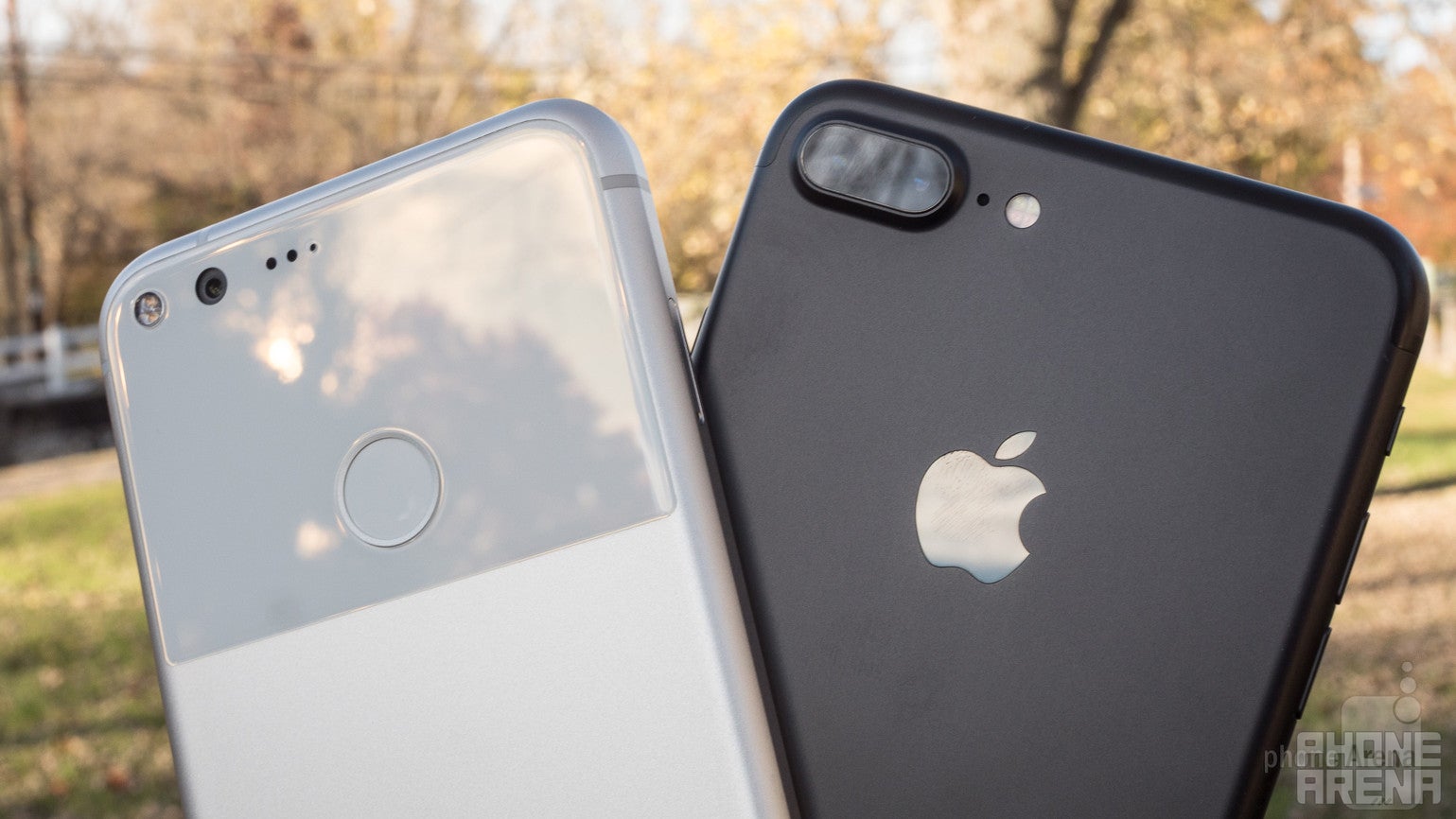
Smartphones may rely upon millions of lines of code, a dizzying array of tiny transistors, and more high-tech components than you can count, but there's little that affects our impressions of a handset more than its design and styling. Looking at both the iPhone 7 Plus and the Pixel XL, it's clear that a lot of thought went into making these handsets look and feel the way they do, all while Google and Apple made some very different decisions about how to put their phones together.
The iPhone 7 Plus is sleek, sturdy, and smooth. The phone scales up the dimensions of the iPhone 7 to accommodate for the Plus model's larger 5.5-inch screen, and while it's slightly thicker than the smaller handset, we're talking a near-indiscernible amount – to the tune of a fraction of a millimeter. But not all of the phone's hardware can squeeze into that slim body, and like the iPhone 7 itself, the Plus has to live with a camera bump, but it's significantly more pronounced on the 7 Plus: it both sticks out further, and takes up more surface area to make room for the phone's dual rear cameras.
While the Pixel XL is a thicker device than the iPhone, Google both manages to keep its thickness consistent from smaller to larger Pixel, as well as avoiding a camera bump altogether. This however, is at the cost of having the profile of the phone get progressively thicker towards the upper end. The handset's design is a bit unusual, taking advantage of multiple materials in a way that's unexpected but also really help the phone stand out in a busy Android market. Like the smaller Pixel, an edge design that shifts from curves, to flat surfaces, to angled bevels helps keep the handset feeling secure in your hand, which is a plus considering the phone's size.
Comparing the two phones against each other, while Apple's is the thinner handset, to the tune of more than a millimeter, Google's manages to be both shorter and narrower, despite the same 5.5-inch screen size.
Display
Big and bright, or big and pixel-dense – which matters more to you?
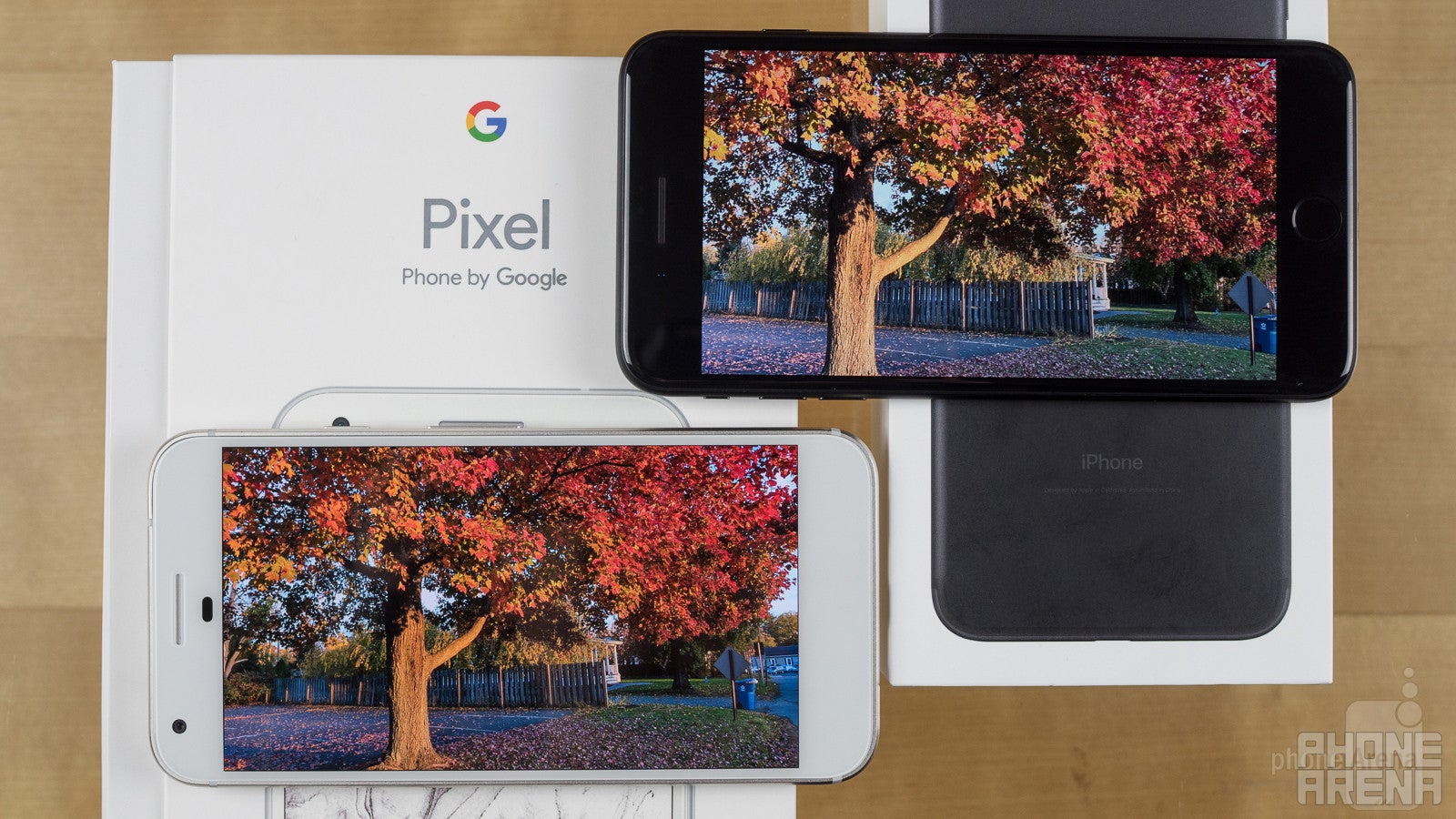
OK, now we're getting down to brass tacks: while the design of the Pixel XL and iPhone 7 Plus may carry over from the smaller versions of those handsets, each of these larger editions introduces a new screen, finally giving us something meaty to compare.
This time we're not looking at two differently sized components, with both the XL and 7 Plus going with 5.5-inch screens. But just as was the case with the smaller phones, Google outdoes Apple in terms of pixel density and resolution, giving it a 5.5-inch, 1440 x 2560 AMOLED panel to the iPhone's 1080 x 1920 screen – the same resolution as the 5-inch Pixel. But while Google may have an edge in sharpness, that doesn't have a big impact on general usability, and the iPhone 7 Plus still looks impressively crisp in handheld usage. Google may be putting those extra pixel to good use when you strap the Pixel XL into a Daydream View headset and start giving VR a spin, but they don't change the day-to-day experience much.
Like we noted with the smaller phones, Apple's screens are noticeably brighter than Google's, helping with outdoor visibility. And though both the Pixel XL and iPhone 7 Plus are both brighter than their siblings, Apple still comes out way in the lead here.
Interface and Functionality
Do these smartphone platforms take full advantage of phablet-sized handsets?
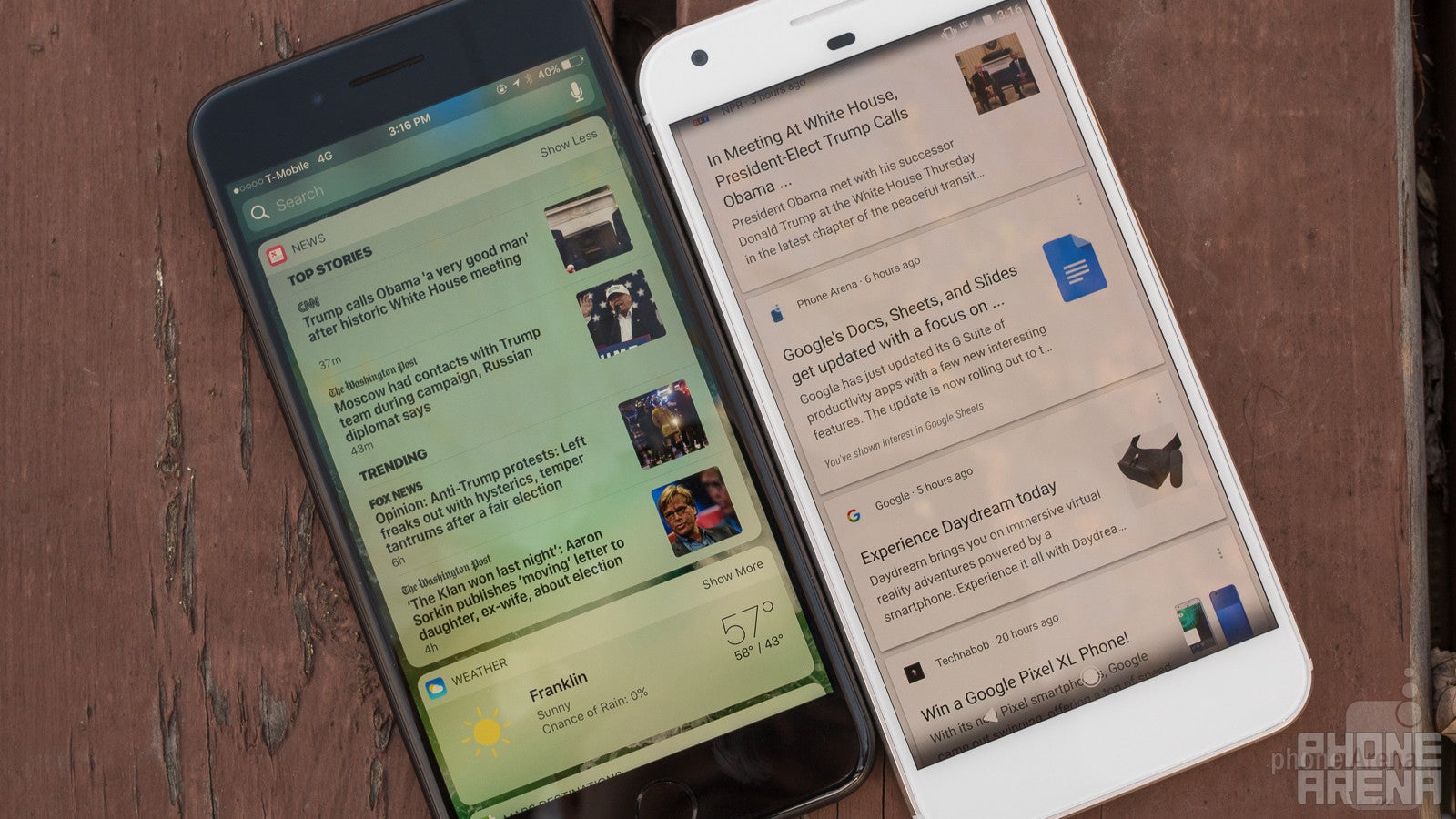
Addressing the interfaces of the iPhone 7 Plus and the Pixel XL is a complicated question, as we're not talking about the bells and whistles some third-party Android OEM added to spruce up their handset: this is basically a pure iOS versus Android debate. And that's both a conversation that's been had time and time before, as well as one that takes the spotlight away from these two specific phones. So rather than rehashing iOS vs. Android as a whole, how do these two platforms impact the usability of these specific phones?
Well, both make good use of their operating systems' voice assistants, and while Siri's an iOS mainstay, Google Assistant on the Pixel XL is both quite new and something (for now) unique to the Pixel phones. But while Google Assistant makes big promises, especially in terms of the conversational nature of its interface, it's still a bit of a work in progress – with more than a few rough edges.
For example, right now if you say “OK Google” and ask the Assistant to help you identify a song that's playing, you're told that feature isn't available. Yet if you manually tap on the Google search widget and hit the mic icon to activate its voice-search mode, it's more than happy to let you know what you're listening to. That disconnect is odd, and indicative of the work that still needs to happen on the Google Assistant.
Both of these are bigger phones; how well do they handle users who might have hands on the smaller side? On the iPhone 7 Plus, a quick double tap on the phone's home button slides the screen down for easy one-handed operation. On the Pixel XL, meanwhile, about the only help you're going to get in that department is an on-screen keyboard that shrinks down and slides over a tad – but most on-screen elements will remain just as out-of-reach as before.
One area where the Pixel XL really does take full advantage of its screen real estate is through Android Nougat's split-screen app mode. It works just like on the smaller Pixel, but here the larger screen and higher resolution make the feature that much more enjoyable to use. And while we can maybe understand Apple's decision to keep split-screen off the 4.7-inch iPhone, it's a darn shame that the larger iPhone 7 Plus can't take advantage.
Processor and Memory
Meager upgrades spell similar performance to their smaller siblings
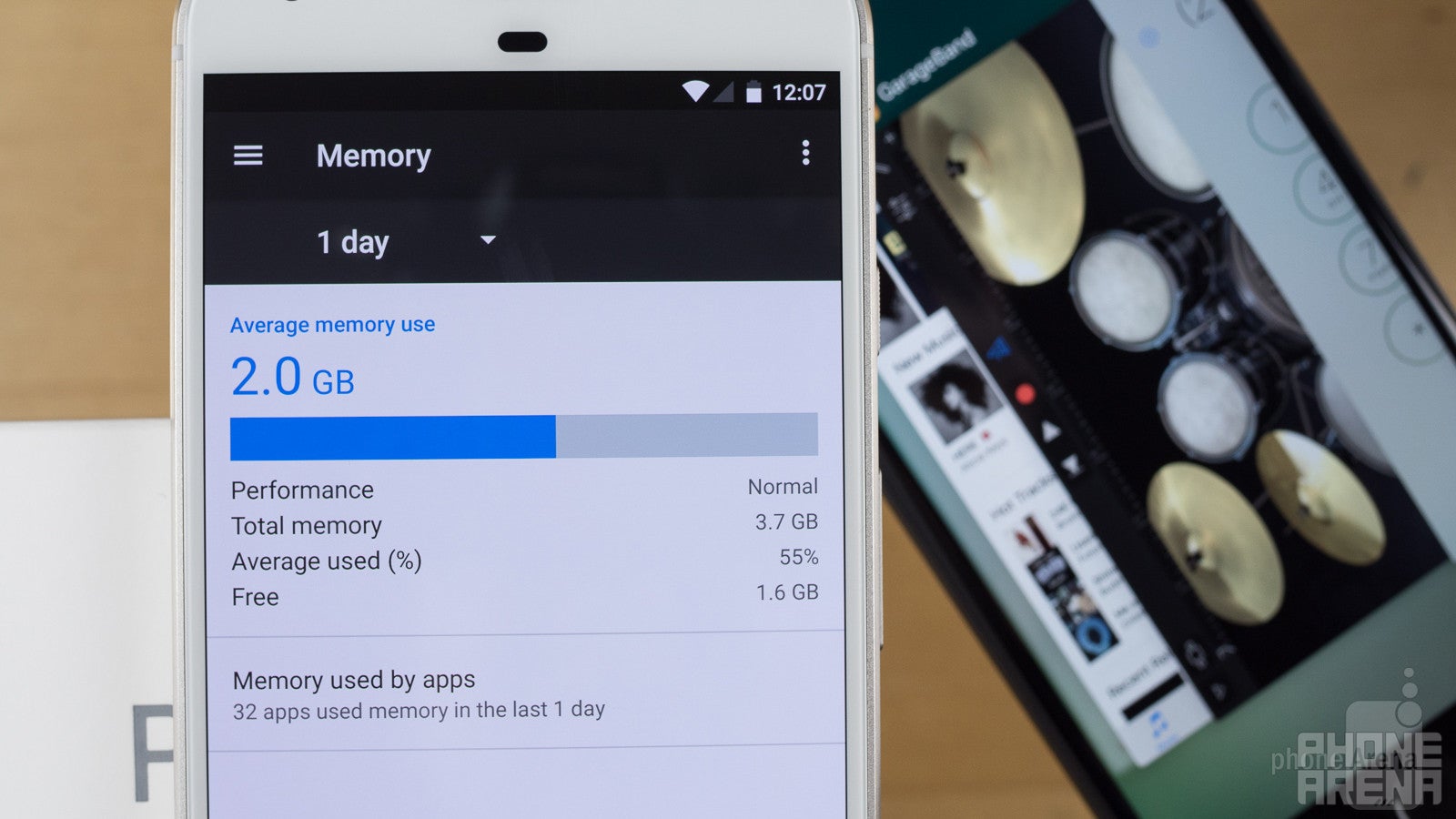
The Pixel XL runs the very same silicon as the smaller Pixel: a Snapdragon 821 paired with 4GB of RAM. Apple, meanwhile, brings a small upgrade to the iPhone 7 Plus, returning with another A10 Fusion chip but bumping system memory from 2GB to 3GB.
That means that both these phones perform on close to the same level as their smaller versions, but we did notice a few really minor differences in performance, likely due to both these handsets featuring higher-res screens and correspondingly needing to render and move so many additional pixels. But really, we're talking single-digit percentages in artificial benchmarks here – nothing to get too worked up about.
Instead, just as we found with the Pixel and iPhone 7, the XL and 7 Plus are each well equipped to deliver fast system-wide performance, with minimal stutter and a largely smooth, pleasant-to-navigate user experience.
The extra RAM in the iPhone 7 Plus may end up making a difference when you're going a bit crazy with the multitasking, or leaving a million Safari tabs open, but in casual use it doesn't seem to have an immediate impact on iOS performance.
Connectivity

The way Google and Apple's larger phones interact with the world is much the same as their smaller editions: both enjoy some broad carrier support, including both GSM and CDMA-based carriers. But just like we noted with those more pocket-friendly handsets, Apple enjoys the distinct advantage of better carrier in-store availability, while Google's going the possibly risky route of a Verizon-exclusive deal. You're still able to operate the Pixel XL on other networks, but will have to take a little more initiative to get set up.
The wired connectivity story is much the same, as well, with reversible ports on both phones: Lightning on the iPhone 7 Plus, and USB Type-C on the Pixel XL. That sounds like doing the same thing two different ways, but the Pixel XL does have the cool advantage of being able to charge other USB Type-C devices over its port, acting like an external battery pack.
Camera
The dual-camera iPhone 7 Plus arrives with something to prove – but will the Pixel XL best it?

Finally we're getting to another of the big points of interest in this comparison: the cameras. Google gives the XL the same 12.3MP Sony camera we saw on the Pixel, so we're not in for any surprises there, but Apple's changing the rules for the camera on its jumbo-sized iPhone, and this year the iPhone 7 Plus arrives with an all-new dual-camera system, combining wide-angle and telephoto lenses to enhance image quality, offer a real optical zoom, and support stylistic processing effects (like the new Portrait mode).
Image quality
More and more, great smartphone image quality leans on post-capture processing. Don't get us wrong: having a high-quality sensor and lens are absolutely critical, too – you can't make a great cake with rubbish ingredients – but the recipe you follow next is just as important.
With the iPhone 7 Plus, we're looking at multiple processing steps – the first of which combines the output of the phone's two cameras to find the best parts of each. We also shot all our sample pics with Apple's HDR processing in auto mode, so whenever the software deemed it necessary, the camera combined multiple exposures for our final pic. That's a lot of decision-making going on behind the scenes, all in the aim of producing the best pictures.
The Pixel XL does its own fair share of post-processing, but its job is greatly simplified by having only one sensor from which to draw to imaging data. Just like on the iPhone, we used the Pixel XL's automatic HDR settings.
Like we saw in our comparison between the smaller Pixel and iPhone 7, there's a fair amount of tonal variance between shots – sometimes the iPhone 7 Plus captures warmer pics than the Pixel XL, and other times they look a bit cooler. But one thing we noticed throughout our testing is that the Pixel XL seemed to better manage complicated exposures.
Consider the shot of the row of trees; while both images are nicely in focus, the iPhone overexposes both the sidewalk and the white house in the background, while the Pixel manages to preserve a lot more detail. Or look at the pictures of the produce aisle; both cameras capture the bold colors of these fruits, but those on the top shelf (which are just inches away from harsh fluorescent lighting) are blown-out on the iPhone, while the Pixel manages to show us a lot more.
Where lighting conditions aren't so complicated, the two cameras perform much more on the same level. Compared to the Pixel XL, the iPhone 7 Plus does have the edge of its optical zoom.
Video recording
Video performance was already a close race between the iPhone 7 and Pixel, and with the 7 Plus and Pixel XL, the story's more of the same. Just as we noticed with that previous set of devices, the Pixel seems to lean towards darker exposures with video than the iPhone, and on an overcast day like the one we were filming on, we appreciated the slight brightness lead with the 7 Plus. This is still an exceedingly close race, and flipping back and forth between the two, it's really difficult to identify one as the better-looking camera.
Stabilization works quite nicely on both phones, and they're both champs when it comes to video refocus times. In short, we wouldn't have any problems recommending either smartphone to someone looking to shoot a lot of high-res video.
Multimedia
An unconventional stereo pair wows us with great sound quality
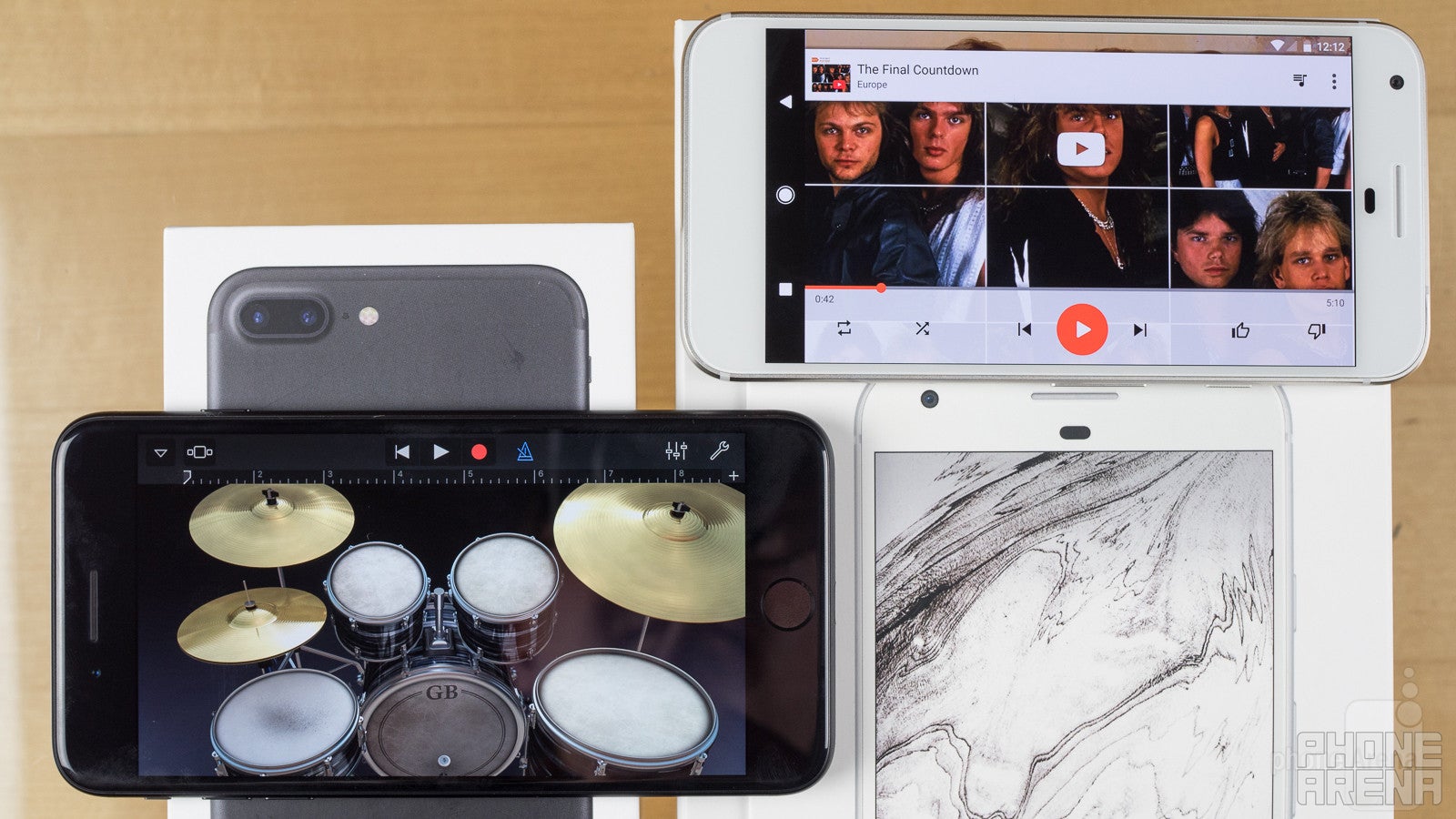
Big-screen phones like these two really lend themselves towards media consumption, but a large, beautiful screen is just half of the equation there; how these devices sound is just as critical.
The Pixel XL is capable of producing some pleasing audio from its on-board speaker, but the iPhone 7 Plus really blows it away: there's a cleaner spread of frequency coverage, while treble notes on the Pixel can occasionally be overpowered by the bass. More than that, though, the iPhone 7 Plus is a lot less reliant than the Pixel XL on you needing to hold the phone just right to get the best sound out of it, making casual listening a lot more satisfying.
But while the iPhone 7 Plus may sound better than the Pixel XL phone-versus-phone, things take a turn when you start reaching for audio accessories; while both models love connecting to the latest Bluetooth gear, the need to carry around an adapter to use analog headphones with the iPhone 7 Plus is nothing less than a hassle. If you're absolutely, 100% ready to go full-digital with your music-listening, the iPhone 7 Plus won't let you down, but if you're not quite ready to make that plunge, the Pixel XL could be a good compromise that lets you keep all your options open.
Call Quality
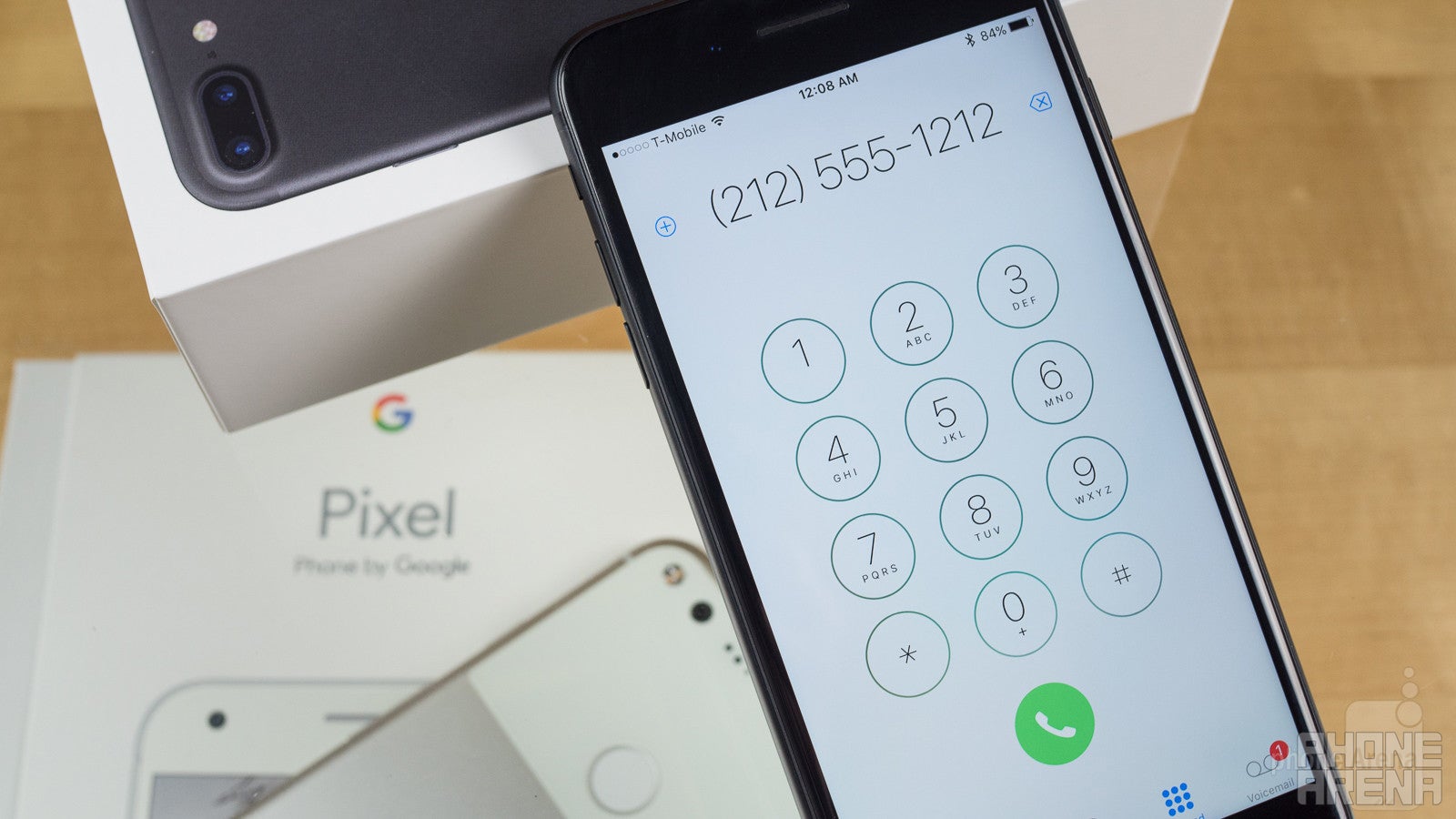
Shock of shocks: with all this high-end hardware inside, calls on both phones sound stellar. It's a tough judgment, but if we had a gun to our head, the iPhone may deliver calls with a lower noise floor, helping you to sound exceptionally clear – but that's by a small margin, with the Pixel still sounding great under most circumstances.
Battery Life
Google strikes a delicate balance, giving Apple room to pull ahead

Just like the smaller phones, the Pixel XL has a larger battery than the iPhone 7 Plus, but the gap is starting to close, with the Pixel XL's 3,450 mAh battery only 19% bigger than the iPhone's 2,900 mAh battery (whereas the Pixel's is almost twice as big as the iPhone 7's).
Unfortunately for Google, the Pixel XL seems to need all that extra juice just to keep its big, high-res screen running, and our constant-brightness screen-on test didn't show the phone lasting any longer than the smaller Pixel. Apple manages not to suffer the same fate, and the iPhone 7 Plus adds a solid hour-and-a-half to the iPhone 7's run time. So while the iPhone 7 and Pixel were pretty evenly matched in terms of battery life, with the larger handsets the iPhone 7 Plus emerges as the decisive winner.
Well, that's the case for discharge times, anyway, but there's a flip side to great battery life on the iPhone 7 Plus: it also takes much longer to recharge, and while the Pixel XL can go from empty to full in under two hours, the iPhone 7 Plus needs north of three.
Conclusion
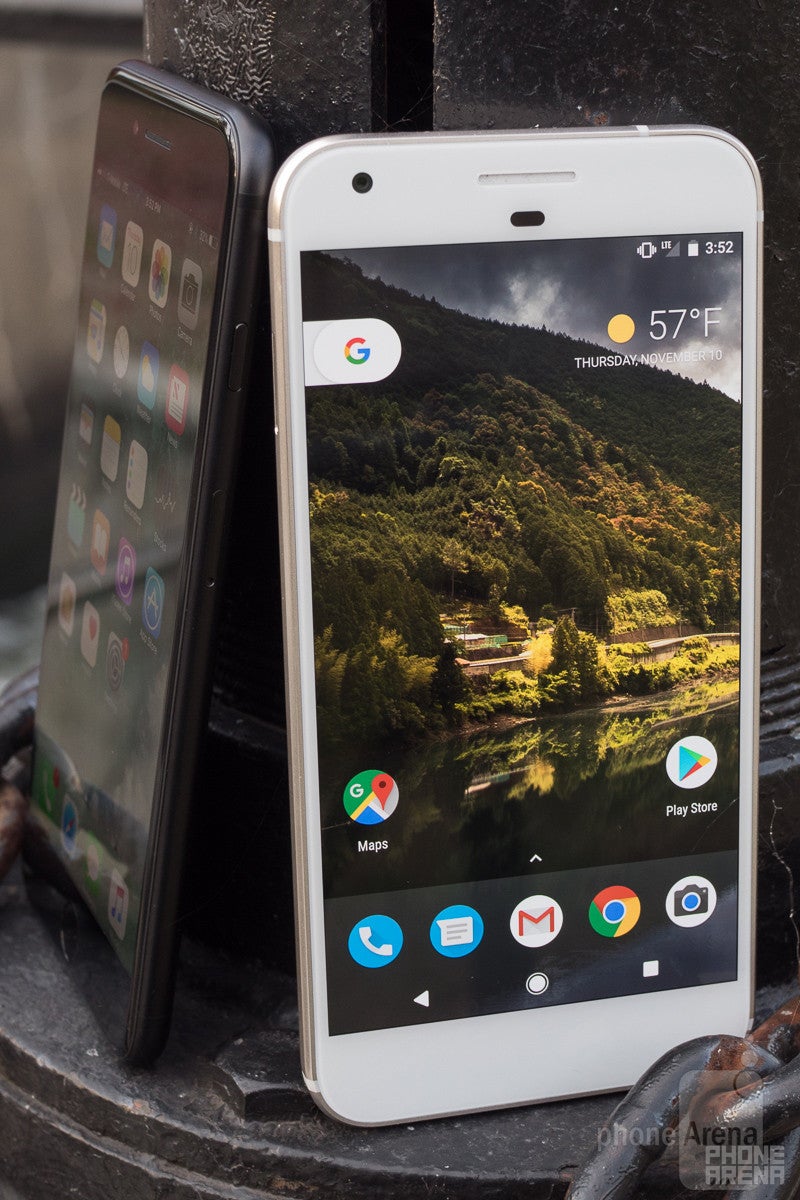
Pricing is right on par as well, with both phones starting at $770 for their 32GB models, or $870 for 128GB. And just as was the case with the little phones, Apple offers a higher-end 256GB option, as well as a greater variety of colors: five to the Pixel XL's three.
One important consideration, at least at this present moment, is availability. The iPhone 7 Plus quickly became hard to come by immediately after it launched, but by now orders are shipping in three to four weeks. The Pixel XL, meanwhile, is out-of-stock at many retailers (including the Google Store), with no promises about when it may arrive. So should you just go with the iPhone because it's easier to get your hands on?
Well, once again this one comes down to personal taste. A huge component of that decision concerns your feelings towards iOS and Android, but even if you're flexible there, you have to look at other things that matter. Is waterproofing a big concern? Would you rather have a higher-res display or a brighter one? There's no easy answer to “is this the right choice for most shoppers,” but hopefully with the breakdown we've brought you here, you're a lot better equipped to decide which factors are more important to you, and choose the phone you'll be most happy with.
Google Pixel XL
Pros
- More flexible camera exposure
- Fast recharge times
- Headphone jack
- Higher-res display
Apple iPhone 7 Plus
Pros
- Brighter screen
- More color/storage options
- Optical zoom
- Slimmer build
- Stereo speakers
- Longer battery life
- Waterproof

Follow us on Google News

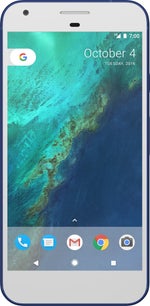

















![A new Android bug is making it impossible to install new apps. Are you affected? [UPDATE]](https://m-cdn.phonearena.com/images/article/176703-wide-two_350/A-new-Android-bug-is-making-it-impossible-to-install-new-apps.-Are-you-affected-UPDATE.webp)

Things that are NOT allowed:
To help keep our community safe and free from spam, we apply temporary limits to newly created accounts: